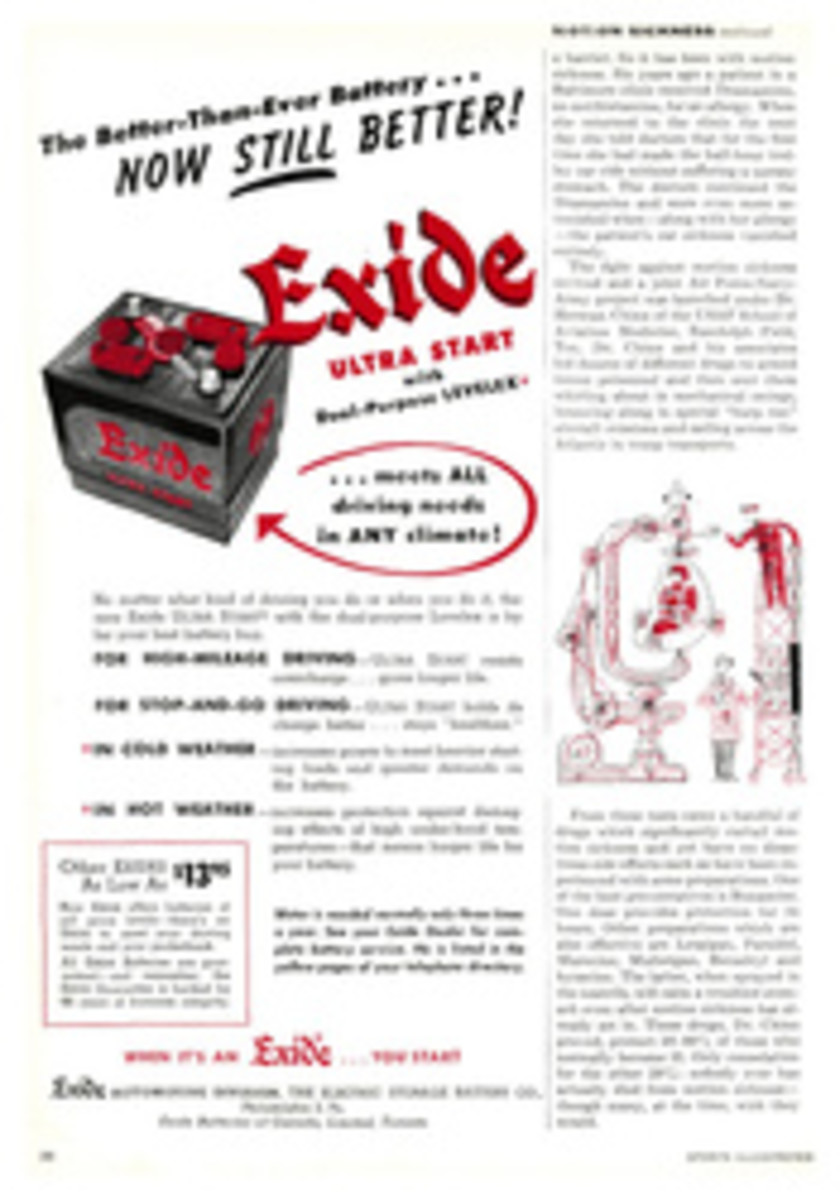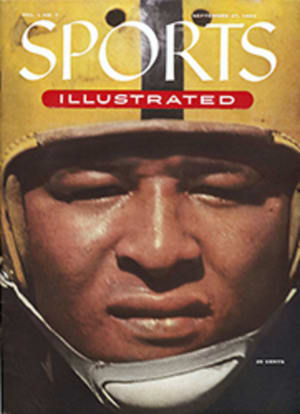
A DAY FOR THE BRAVE
WATKINS GLEN, N.Y.
This is a course for brave men," said that wizard of the wheel, Phil Walters, "—and I am not a brave man!" He had just taken Briggs Cunningham's 4.5-liter Ferrari on a fast practice session (3 min. 9 sees.) around the 4½-mile Watkins Glen, N.Y. road course in preparation for the Seventh Annual Sports Car Grand Prix last Saturday. Brave man or not, Walters—despite a long lay-off—showed his usual consummate skill by winning the 101-mile main event, in a downpour which threw many of the 24 starters into hectic slides. The hazards facing drivers on this new course also include climbs or downward zooms on 76% of every lap, and a l-mile, 130 mph down-hill straight with a curve at the end. Many of the fast cars were airborne for 20 feet at a time as they planed off the humps.
UPSETS AND UNSCHEDULED INCIDENTS
This year's Watkins Glen races drew an all-time record entry of 223 sports cars, of which 177 passed technical inspection. Some 50,000 people formed a huge hedgerow around the course. Numerous upsets on form and some unscheduled incidents intensified the excitement and suspense. An MG lost a wheel at Post No. 3, injuring a luckless flagman and briefly disrupting telephone communications. A private plane crashed into a barn near the course. The huge, jam-packed grandstand, the blare of the public address system, the leaden light of an invisible sun mingled with those scents and sounds dear to the enthusiast—the pungent reek of alcohol, the cloying odors of hot oil and scuffed rubber and the metallic bark of open exhausts.
Walters did not ride the Ferrari in the Grand Prix, but a heavier, slower and less maneuverable Cunningham. Bill Spear, driving his maroon 4.5 Ferrari, jumped into the lead at the outset and with magnificent dash completed the first lap in 3 min. 13.7 secs,—an average of 84 mph from a standing start. Walters, however, stalked him like a shadow, only two seconds astern, and no matter what Spear did he could not widen the gap to more than seven seconds. "Gentleman Jim" Kimberly (4.5 Ferrari) lay third, but gradually fell back until on lap 7 he was 41 seconds behind. On lap 11, Spear unfortunately retired with a stripped rear axle and Walters took the lead, never to relinquish it. Johnston overdid things at the hard right turn into the pit straight and dramatically nosed the big white and blue Cunningham down the escape road, but he got going again without losing third spot to Walt Hansgen's C-Type Jaguar. Briggs Cunningham (4.5 Ferrari) never showed higher than sixth. Walters completed the 22-lap Grand Prix in 1 hr. 12 min. 46.4 sees., an average of 83.3 mph. Kimberly averaged 81.4 mph and Johnston 81.3 mph; but to Spear went the honor of the fastest lap (his eighth) at 86.6 mph.
A TEMPERAMENTAL PORSCHE
Four shorter events preceding the Grand Prix packed the day with some spectacular racing. In the Seneca Cup (11 laps, 50.6 miles for unrestricted cars and sports cars of all classes) the favorite among 34 starters was Gordon "Tippy" Lipe whose temperamental, supercharged Porsche-Cooper can outaccelerate almost anything. Lipe got clean away from the field for two laps, pursued by Phil Cade in a veteran Maserati, and by that phlegmatic sportsman, Dr. M. R. J. Wyllie with a C-Type Jaguar. However, the Cooper-Porsche lost its verve after two laps and quit on the fourth. Wyllie took the lead on lap 3 and held it to the checkered flag. Paul Timmins was second in his Hansgen-Jaguar Special, and Alan Patterson II placed third with an Allard. Wyllie averaged 76.2 mph.
The Collier Brothers Memorial Trophy (same distance but for stock MGs only) saw another upset when Gus Ehrman (TD MG) beat favorite Ralph Durbin (TF MG) by a few yards after a terrific battle. Bill Long was third in another TF MG. Ehrman averaged 61.2 mph; Durbin 61.1 mph. There were 36 starters and the three leaders traded places six times.
The Glen Trophy, also of 51.6 miles but for production sports cars over 1,250 cc, brought 54 entries and again tossed the odds overboard. Charles "Chuck" Wallace with an unbroken string of 12 victories in Jaguar races this season was cinched to win overall, yet he never ran better than sixth due to a faulty brake pedal. Max Goldman and Dick Thompson were an even bet in the Porsche class, but both had trouble—Goldman being hit by another car and Thompson losing a piston. Bill Kincheloe Jr., Austin-Healey trump card, spun out when his overdrive control failed. Dick Perrin (Jaguar) took the overall checker at 73.6 mph; George Constantine and Warren Smith, both in Jaguars, were second and third. Bob Magenheimer won the Porsche class, with Thompson limping home second and Warren Steel in third. Britisher Roy Jackson-Moore headed the Austin-Healey class and Jim Robinson earned the laurels for the Triumph contingent.
LIKE OLD TIMES
The 34 starters for the Queen Catharine Cup (16 laps, 73.6 miles, for modified sports cars under 1,500 cc) included no less than eight Oscas, three of which, as expected, filled the first three overall places. Frank Bott led all the way at 78.5 mph, followed by John Gordon Bennett (77.8 mph) and Phil Stewart (75 mph). Rees Makins, however, whose 1,100 Osca has scooped every Class G event this season, broke his winning streak. A flat tire cost him two laps in the pit, but he still managed a third behind Tony Pompeo in my Siata. Bob Keller (Siata) was first home. Marshall Lewis, driving Briggs Cunningham's new Stanguellini, not only ran away with the 750 cc class but finished sixth overall—an amazing performance.
It was like old times again at Watkins Glen.
PHOTO
M.R.J. WYLLIE'S JAGUAR LEADS PACK AROUND TURN IN WINNING RUN OF 50.6-MILE SENECA CUP

